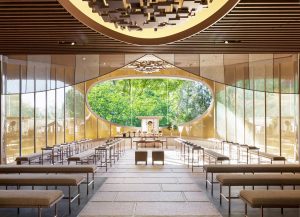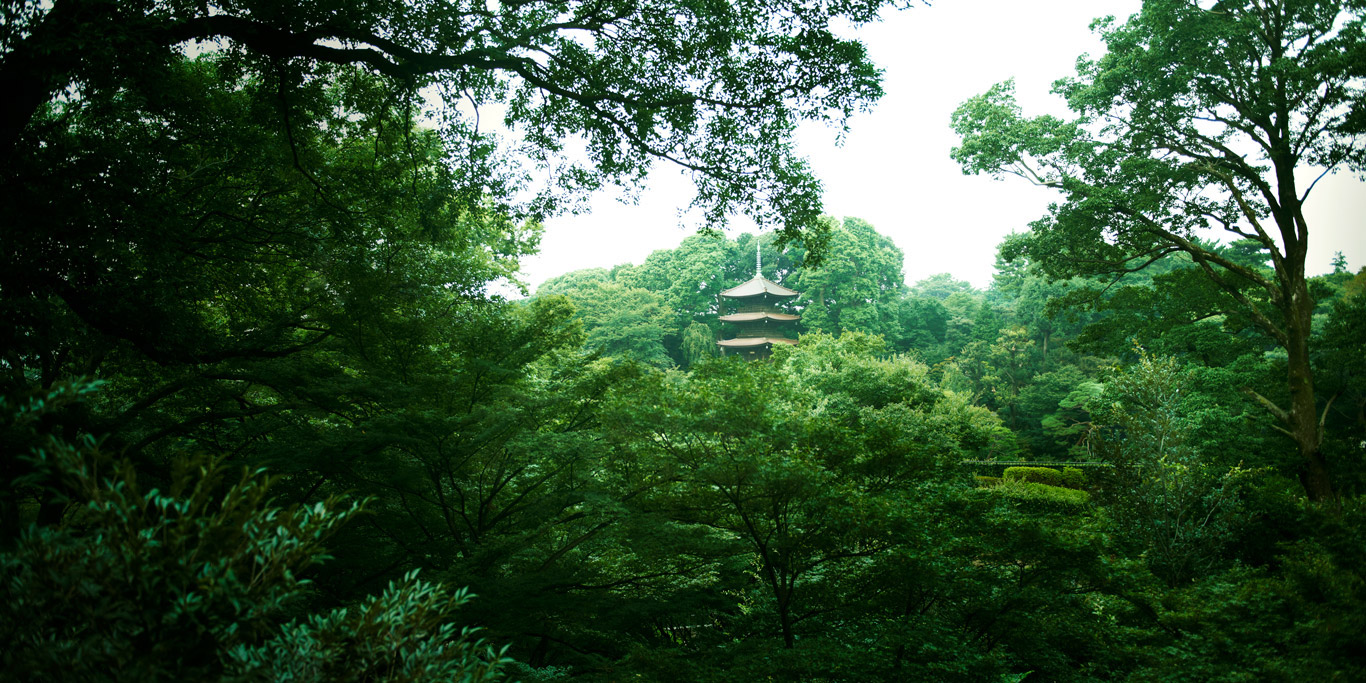
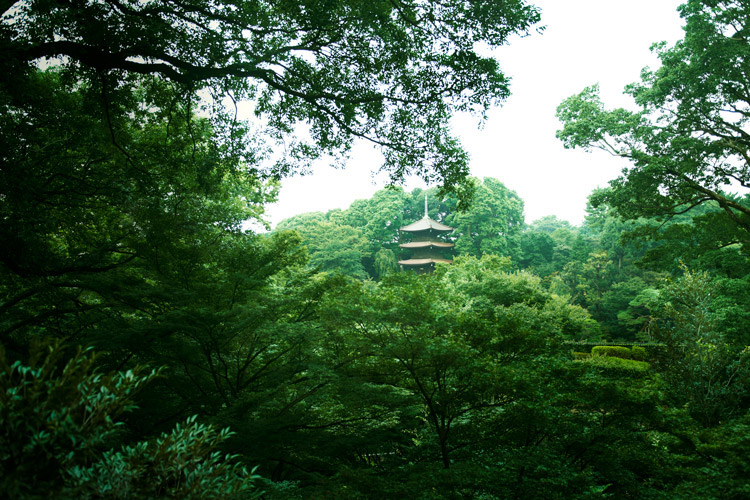
庭园与活动
东京椿山庄大酒店的“今”・看点
Traditional and Modern Japanese Architecture at Hotel Chinzanso Tokyo
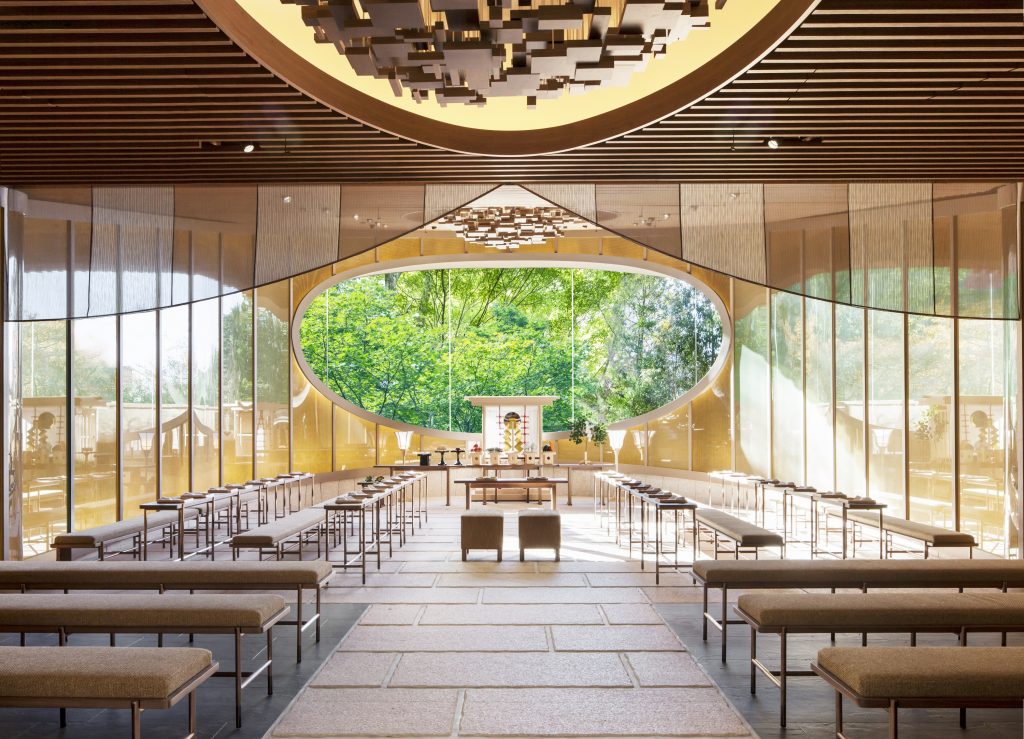
The iconic Three-Story Pagoda, that Hotel Chinzanso Tokyo is famous for, happens to be one of only three ancient Buddhist towers of its kind in Tokyo. A monument of rare beauty, this pagoda has inspired the logo of the hotel.
However, Hotel Chinzanso Tokyo is home to several other impressive items of Japanese traditional and contemporary architecture. A stay at the hotel is an opportunity to admire beautiful structures such as shrines, traditional Japanese buildings that have been relocated here from other regions of the country, stone lanterns, bridges, as well as contemporary buildings with futuristic designs. This impressively wide range of structures will give you an insight into the features of Japanese architecture. It will indeed feel as if you’ve traveled throughout Japan.
Let us introduce five prominent structures of Hotel Chinzanso Tokyo.
1.Entsukaku, the Three-Story Pagoda that has Traveled through the Centuries
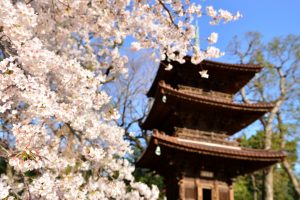
The Three-Story Pagoda in Chinzanso Garden was originally located on the grounds of a temple in Hiroshima called Chikurinji. The pagoda was relocated here in 1925 at the wish of Baron Fujita Heitaro, the owner of the Chinzanso property at the time. Baron Fujita wanted to respect the wish of the former owner of the Chinzanso residence, Duke Yamagata, of keeping this garden as an oasis in the heart of the city. At the same time, the Baron wanted to enrich the garden with historical monuments that could blend naturally into the surroundings. It had come to his attention that Chikurinji Temple had fallen into ruins, so he decided to purchase it and relocate the old temple’s pagoda to the Chinzanso Garden.
It might be surprising for Tokyo visitors that, while there are many Buddhist temples in the city, there are only three ancient pagodas, and Entsukaku happens to be one of them. It is also the only pagoda with three stories, as the other two are five-storied. The truth is that many pagodas and old temple structures have been lost in the fires caused by the Great Kanto Earthquake that shattered Tokyo in 1923 or to the bombings during WWII. Entsukaku miraculously survived the air raids. It also remained without severe damages even after the Great Tohoku Earthquake in 2011, although the event prompted a major renovation of the structure.
The research performed in preparation for the renovation concluded that the materials Entsukaku consisted of were from around 1420. The pagoda itself is thought to have been originally built in the twelfth century. As one of the oldest existing wooden pagodas in Tokyo, it has been designated a Tangible Cultural Property of Japan.
When viewing the Entsukaku, pay attention to the intricate woodwork that gives the pagoda a gorgeous appearance despite the fact that it is unpainted. Pagodas built more recently have a much simpler design but are often painted in a vibrant vermillion color. The door to the altar is open during the day revealing the beautiful statue of Kanzeon Bosatsu (the Buddhist goddess of mercy) that it enshrines. The ceiling of the altar, painted in red and green, was renovated based on the original.
The Three-Story Pagoda within Chinzanso Garden is an exquisite example of Buddhist architecture. Its dignified appearance stands out from any angle but is especially impressive when viewed from one of the rooms with a garden view at Hotel Chinzanso Tokyo. Surrounded by contemporary concrete buildings, with Tokyo’s skyscrapers in the background, the Three-Story Pagoda has a surreal beauty, especially when it is illuminated at night. It seems to connect the Tokyo metropolis to the all-encompassing stream of history.
2.Shiratama Inari Shrine – Behold a Shinto Altar

The Shiratama Inari Shrine is a small Shinto altar that was originally on the grounds of the prominent Shimogamo Shrine in Kyoto. Shimogamo Shrine is one of the oldest shrines in Kyoto, even older than the city itself. It flourished during the Heian period (794-1185) when it was particularly favored by the Imperial Court. Shimogamo Shrine stands at the origin of Aoi Matsuri (“Hollyhock Festival”), one of Kyoto’s three great festivals. Aoi Matsuri was initiated here at the beginning of the ninth century and is still being held to this day every year on May 15th with a grand procession from Shimogamo Shrine along the Kamo River toward its twin, Kamigamo Shrine.
The altar within Chinzanso Garden was relocated here from Shimogamo Shrine in 1924. Shiratama Inari Shrine is an altar dedicated to Inari, the guardian deity of crops and prosperity. The distinctive feature of all Inari shrines is that their entrance is guarded by statues of white foxes. Foxes are believed to be the messengers that carry the worshippers’ prayers to Inari.
The vermillion torii gate, a specific feature of Shinto shrine architecture, marks the entrance to sacred ground. Shinto is a system of myths and beliefs rooted in nature and this is reflected by the simplicity of shrine architectural structures. Shinto shrines and altars are usually made of wood and blend in naturally amid surroundings full of greenery.
3.Ryotei and Ryokan – Traditional Japanese Architecture
At the Japanese-style restaurants of Hotel Chinzanso Tokyo, guests can enjoy the elegant atmosphere of traditional Japanese interiors.
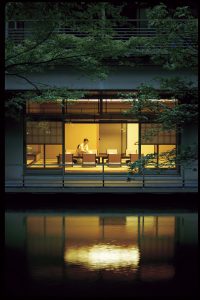
At Kinsui, the ryotei restaurant in the garden, you will be welcomed by truly refined Japanese architecture where the guests’ dining experience is enhanced by the sounds and sights of nature outside. The private dining rooms are spacious and have tatami mat flooring, sliding doors, and tokonoma alcoves. In these spaces, guests can feel the quintessence of classic Japanese interiors with their unadorned elegance.
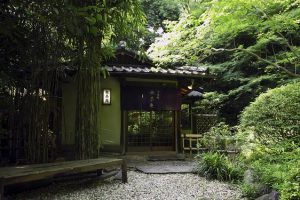
On the other hand, dining places like Mucha-an and Mokushundo have a retro atmosphere. These buildings are actually more than one hundred years old and have been renovated after being located in Chinzanso Garden.
Here visitors can enjoy the intimate atmosphere of traditional wooden interiors. The near darkness, that is characteristic of these spaces, makes us more aware of the presence of natural light, which enhances the colors of foliage and the flowers outside, as well as the colors of the dishes on our plates.
By visiting these structures, you’ll be able to notice the ways in which traditional Japanese architecture incorporates nature. First of all, the main materials used for construction are wood, paper, and bamboo. Secondly, the large windows are open toward the world outside, letting in the sound of flowing water, of the rain, or of the chirping birds, along with the sights of the garden. Even the rooms, that are separated from the garden, usually have a corner where the host arranges some seasonal flowers. It’s not an exaggeration to say that Japanese interiors are never separated from nature.
4.Mori no miya – The Futuristic Garden Sanctuary

Hotel Chinzanso Tokyo is famous as a venue for wedding ceremonies. Among the several ceremony halls on the precincts, the Mori no miya Garden Sanctuary stands out through its impressive structure that combines Shinto shrine elements with contemporary architecture. This hall, completed in 2017, enshrines the deities of Izumo Taisha, a great shrine in Shimane Prefecture dedicated to the gods of marriage and relationships.
Take a step inside and you will feel the particular love and respect for nature that is present in any type of traditional Japanese architecture. However, here, traditional architecture is taken to another level through a futuristic approach. The design with ascending lines that meet at the center symbolizes the wish for a future full of happiness for the newlyweds. This interior truly projects the present moment into the future.
The main material used for building this sanctuary is wood. Moreover, its rooftop garden blends in perfectly with the beautiful Chinzanso Garden.
5.Hotel Chinzanso Tokyo – Elegant Contemporary Architecture Open to the World

Another structure that will surely capture the attention of architecture enthusiasts is the building of Hotel Chinzanso Tokyo itself. From the lobby to the hallways and the layout of the rooms, the hotel has a tasteful contemporary architecture that meets the highest international standards. It was designed as an environment where any guest, no matter the country they come from, should feel just as comfortable as they would feel at home.
The current building underwent a series of renovations completed in 2020. A particular feature of the guestrooms is that the balconies have windows on two sides, offering a wide view of the garden and of the city. Although the building employs Western architecture, the details of the decor in the lobby and in the rooms use Japanese materials and motifs, such as vases of refined Arita porcelain, Japanese woodblock print art, and bed decorations woven in Nishijin, the famous traditional weavers’ district of Kyoto.
It can be said that the building of Hotel Chinzanso Tokyo, nestled in its beautiful garden full of historical monuments, embodies the values of contemporary Japan — the values of hospitality and openness toward the world — while cherishing nature and historical roots.
More Architectural Treasures to Discover
Above we introduced five different structures that can be observed at Hotel Chinzanso Tokyo, from Buddhist and Shinto architecture, to contemporary Japanese buildings. But there is still more to discover if you take a leisurely walk in Chinzanso Garden. Zangetsu, a century-old tea ceremony house, that was relocated here from Hakone in 1947, and was designated a Tangible Cultural Property of Japan, historical stone lanterns that miraculously survived natural disasters, Buddhist statues and structures, and a beautiful vermillion bridge named after a legendary character–Chinzanso Garden is full of monuments that exemplify Japanese architecture from various ages and regions.
The best way to enjoy this treasure trove of architectural marvels to the fullest is by taking a guided tour of the garden, which highlights the connection between Chinzanso Garden and the history of Tokyo. After taking in all that this hotel has to offer in terms of architecture, you’ll feel as if you’ve traveled throughout Japan.


